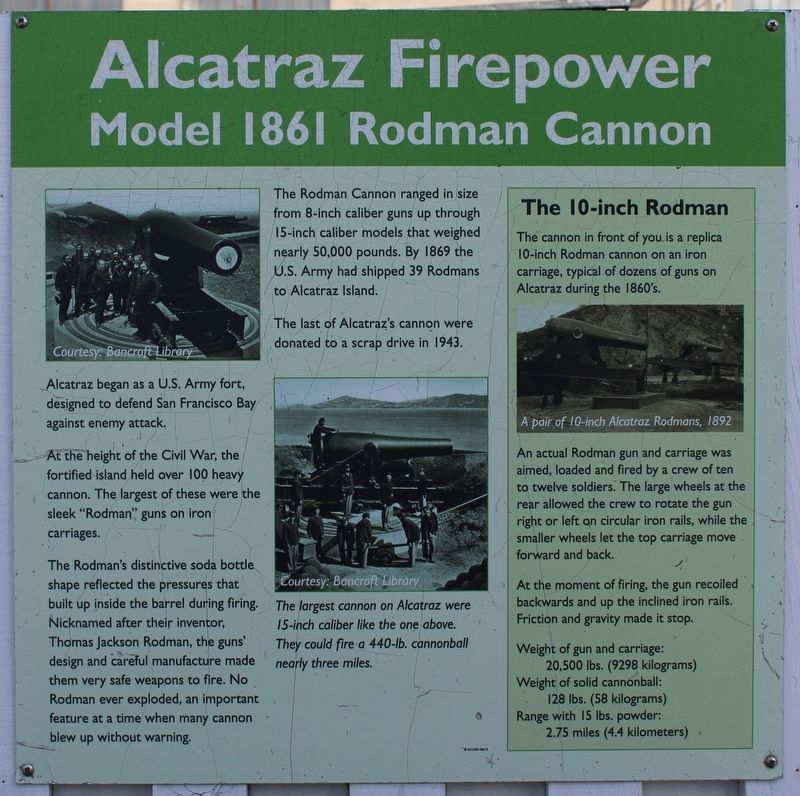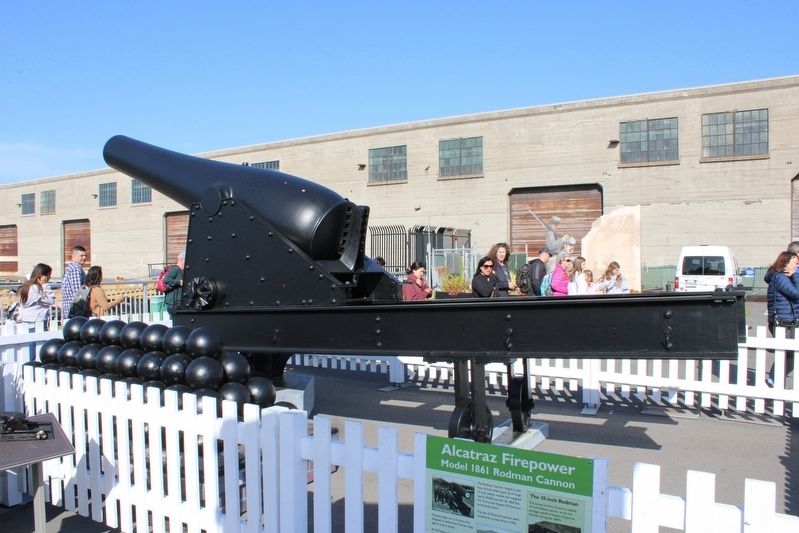North Waterfront in San Francisco City and County, California — The American West (Pacific Coastal)
Alcatraz Firepower
Model 1861 Rodman Cannon
At the height of the Civil War, the fortified island held over 100 heavy cannon. The largest of these were sleek “Rodman” guns on iron carriages.
The Rodman’s distinctive soda bottle shape reflected the pressures that built up inside the barrel during firing. Nicknamed after their inventor, Thomas Jackson Rodman, the guns’ design and careful manufacture made them very safe weapons to fire. No Rodman ever exploded, an important feature at a time when many cannon blew up without warning.
The Rodman Cannon ranged in size from 8-inch caliber guns up through 15-inch caliber models that weighed nearly 50,000 pounds. By 1869 the U.S. Army had shipped 39 Rodmans to Alcatraz Island.
The last of Alcatraz’s cannon were donated to a scrap drive in 1943.
The 10-inch Rodman
The cannon in front of you is a replica 10-inch Rodman cannon on an iron carriage, typical of dozens of guns on Alcatraz during the 1860s.
An actual Rodman gun and carriage was aimed, loaded and fired by a crew of ten to twelve soldiers. The large wheels at the rear allowed the crew to rotate the gun right or left on circular iron rails, while the smaller wheels let the top carriage move forward and back.
At the moment of firing, the gun recoiled backwards and up the inclined iron rails. Friction and gravity made it stop.
Weight of gun and carriage: 20,500 lbs. (9298 kilograms)
Weight of solid cannonball: 128 lbs. (58 kilograms)
Range with 15 lbs. powder: 2.75 miles (4.4 kilometers)
Topics. This historical marker is listed in these topic lists: Parks & Recreational Areas • War, US Civil. A significant historical year for this entry is 1869.
Location. 37° 48.396′ N, 122° 24.256′ W. Marker is in San Francisco, California, in San Francisco City and County. It is in North Waterfront. Marker can be reached from The Embarcadero south of Bay Street, on the right when traveling north. The resin marker is mounted to a fence at the replica cannon on Alcatraz Landing. Touch for map. Marker is at or near this postal address: Pier 33, San Francisco CA 94133, United States of America. Touch for directions.
Other nearby markers. At least 8 other markers are within walking distance of this marker. The 10-Inch Rodman (here, next to this marker); Alcatraz Fire Power (here, next to this marker); Indian Occupiers (here, next to this marker); Military Schoolhouse (a few steps from this marker); Industrial Buildings (a few steps from this marker); The Post Exchange & Officers' Club (a few steps from this marker); Correctional Officers (a few steps from this marker); Guardhouse & Sallyport Complex (a few steps from this marker). Touch for a list and map of all markers in San Francisco.
More about this marker. Inset Images:
The largest cannon on Alcatraz were 15-inch caliber like the one above. They could fire a 440-lb. cannonball nearly three miles.
A pair of 10-inch Alcatraz Rodmans, 1892
Also see . . .
1. Alcatraz's Defenses Revamped, 1869-1876. AlcatrazHistory.com
"The massive 15-inch calibre Rodman Cannons on Alcatraz used small cranes to hoist the solid cannonballs which could be shot at a range of 3-miles."(Submitted on July 17, 2023, by Joseph Alvarado of Livermore, California.)
2. The Man Behind the Rodman Gun. Historynet
"Although in the long run the gun was a technological dead end, the advances introduced by its designer, Brigadier General Thomas Jackson Rodman, revolutionized gun-barrel production and propellant design."(Submitted on July 17, 2023, by Joseph Alvarado of Livermore, California.)
Credits. This page was last revised on July 17, 2023. It was originally submitted on July 17, 2023, by Joseph Alvarado of Livermore, California. This page has been viewed 83 times since then and 32 times this year. Photos: 1, 2. submitted on July 17, 2023, by Joseph Alvarado of Livermore, California.

